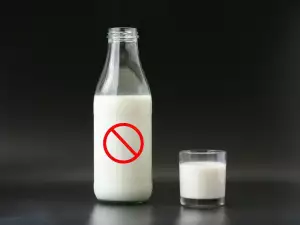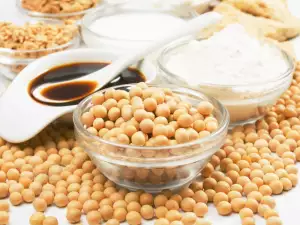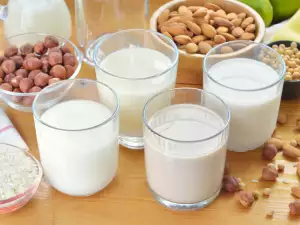Lactose is a disaccharide composed of 2 molecules of the monoccharides beta-D-galactose and beta-D-glucose. They bond using the β1-4 glycosidic bond.
Lactose, also called milk sugar, is 2-8% of the dry substance in milk, regardless if we're talking about buffalo milk, goat milk, sheep milk, cow milk or any other sort.
The name of the disaccharide comes from the Latin word for milk lactis with the suffix -ose used to denote sugars. The hydrolysis of this disaccharide into glucose and galactose is catalyzed by the lactase enzyme.
Use of Lactose
Due to its presence in milk, lactose manages to find its way in our well familiar dairy products, as well as use as a food additive. The main products where it is found in greatest quantities are: milk, yoghurt, whey, feta cheese, cottage cheese, cheese, cream.
Lactose is also used as an additive in a large assortment of other products. It is a vital component in wieners, salami, hams and other sausages. It is found in mixtures for instant soups, creams and mousses as well.

It is used in the industrial manufacture of various sauces such as mayonnaise, mustard and ketchup. Additionally, you'll find it in condensed milk, instant coffee, various canned foods (especially fish), broth cubes, chocolates, bonbons, gums.
It is used in baked goods such as cakes, donuts, cozonacs, cheesecakes and also as a component in certain tablets.
Benefits of Lactose
Lactose is a very important element needed for the development of every young organism. Different kinds of substances are synthesized thanks to it. It enhances the processes of absorption of vitamin C and vitamin B.
Plus it aids in calcium absorption, as well as the spread and development of lactobacilli and bifidobacteria, which in turn are needed for a strong immune system.
Let's not forget that lactobacilli and bifidobacteria are the basis for normal gut flora. According to experts, lactose plays a key role in the proper development of the nervous system in children. In elderly people it prevents the development of certain cardiovascular diseases.
Lactose and Lactase
Lactose is a disaccharide found in breast milk, i.e. mother's milk. Lactase, in turn, is an enzyme that forms in the bodies of babies.
Its role is to absorb lactose and help break it down into glucose and galactose. The production of this enzyme is at its peak when the baby is of breastfeeding age but when people (and animals) grow, production decreases and it becomes harder for them to absorb the lactose.
Dangers of Lactose
The loss of lactase is a normal occurrence in a large part of the population but it does lead to the so-called lactose intolerance.

It turns out that the disrupted absorption of lactose leads to its fermentation in the body, which causes a series of problems, including bloated stomach, intestinal rumbling, formation and passing of gasses, stomach pain, diarrhea, increased peristalsis of the intestines, muscle cramps and others.
Know that lactose intolerance can lead to disruptions in the absorption of certain nutrients and minerals. Unfortunately, the condition worsens with age. It is often mistaken for allergies toward milk but in fact the 2 conditions are completely different.
Some sources claim that the first to consider the presence of such a phenomenon was the ancient Greek physician Hippocrates. He spoke of how some people experienced problems with their stomach after consuming milk. But it wasn't until the last century that lactose intolerance would be described more thoroughly.
If suffering from this problem, patients must follow a specific diet. They should avoid milk and dairy products and include food products in their diet such as soya milk, tofu (soya cheese), fruits, vegetables, legumes, cereals, nuts, fish (as long as it's not canned), eggs, honey, tea, coffee (as long as it's not instant), baked goods suitable for vegans, alcoholic drinks such as beer and wine.
It is theorized that yoghurt, feta cheese and cheese do not cause symptoms that are as severe but even so they too belong to the group of potentially problematic foods.
Furthermore, people who are lactose intolerant require additional vitamin D intake since it helps calcium absorption. It can be taken in the form of a food supplement but it's best to take it through foods such as beef, beef kidneys, pork, liver, eggs, mashed potatoes, mushrooms, caviar, herring, cod, mackerel, catfish, trout, shrimp and others.




















Comments